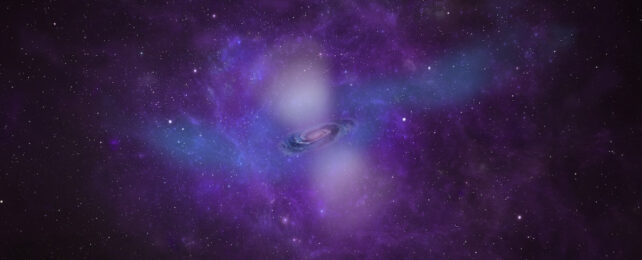Like blazing campfires on cold winter nights, galaxies are surrounded by a smoke of gas and dust that blows into the shadows. This thin pall of material is known as the circumgalactic medium, a halo so vast it contains some 70 percent of the galaxy's visible mass.
In spite of its dominating presence across the Universe, little is known about the medium's typical structure, making it difficult to discern where the edge of one cosmic campfire stops and the next begins.
A new investigation of a single galaxy roughly 270 million light years away has revealed interactions between the circumgalactic medium (CGM) and the galaxy's radiant disc that help define a boundary, one that suggests our own galaxy could stretch farther than we imagined.
If so, the implications could very well mean that the Milky Way's long predicted future collision with the Andromeda galaxy may have already commenced – at least in terms of the two circumgalactic mediums beginning to intersect.
Astronomers from Australia and the US used the highly sensitive Keck Cosmic Web Imager to capture a handful of images centered on the relatively tiny spiral galaxy IRAS 08339+6517 (IRAS08 for short).
Most previous studies on the CGM have taken advantage of the illumination delivered by feeding black holes in even more distant background galaxies. Though the bright light can reveal plenty of detail within the medium, its tight beam limits findings to a tiny portion of the halo.
By capturing a far broader sweep of space some 90,000 light years beyond the edges of the galaxy's glowing disc, the team could analyze tell-tale changes in the medium's makeup.
Some of the field's images featured the thread of neutral hydrogen gas connecting IRAS08 with an even smaller neighbor via the cosmic web, so it's little surprise that the team measured plenty of hydrogen drifting about in the vacuum.
What was unexpected was finding hydrogen stripped of its electrons far beyond the cosmic threads of gas mixed with another, far heavier element – oxygen.
"We found it everywhere we looked, which was really exciting and kind of surprising," says lead author Nikole Nielsen, an astrophysicist from Swinburne University in Australia.
Floating about in the intergalactic nothingness, atoms really only have two sources of heating. One is the pale starlight of far-distant galaxies. The other is an occasional run-in with another atom. Both can be calculated to estimate a pattern of ionization expected of a mix of hydrogen and oxygen.
Using the spectral data in the scattering of images, the researchers mapped changes in the density of ionization on a scale of a few thousand light years, identifying a gently fading zone of influence by IRAS08's own starlight.
"In the CGM, the gas is being heated by something other than typical conditions inside galaxies, this likely includes heating from the diffuse emissions from the collective galaxies in the Universe and possibly some contribution is due to shocks," says Nielsen.
"It's this interesting change that is important and provides some answers to the question of where a galaxy ends."
The discovery not only better defines what a galaxy is, but also how the sprawl of smoke and campfires across the Universe combine and evolve over the eons.
Sitting deep within the Milky Way, it's hard to get a good measure on the limits of where our own galactic boundaries peter out. Generalizing the findings, we could imagine the surrounding expanse of gas warmed by our stars may already be mingling with the halo belonging to our nearest neighbor.
"It's highly likely that the CGMs of our own Milky Way and Andromeda are already overlapping and interacting," says Nielsen.
This research was published in Nature Astronomy.
